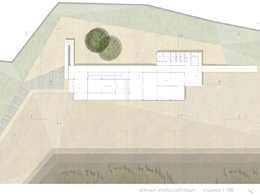STUDENTS PROJECTS
2010

26 September, 2010
Environmental Park at the Lake of Ioannina
Experiential approach of space via changing landscape structures.
Students: Maria Kazana, Panagiota Sakellaropoulou
Supervisors: Nelli Marda, Kostas Moraitis
Consulting professor: Dimitris Papaleksopoulos
School of Architecture National Technical University of Athens
Presentation Date: November 3rd 2009
Summary
Nowadays, especially after the pollution of the ecosystem at the lake of Ioannina, human keeps distance from the natural environment. Our intention is to redefine this interactive relationship between the man, the city and the lake. The environmental park proposes an experiential approach to the history of the city and the natural ecosystem.

The Ioannina basin
The valley of Ioannina is almost in the center of Epirus and is surrounded by high mountains. In the center of the basin lake "Pamvotis" takes shape, and in the middle of it there is a small island. The extent of the lake has been significantly decreased, compared to older times, when it was a single natural ecosystem with the neighboring Lake Lapsista, which was drained in 1954-1958. Nowadays, the ecosystem of the lake belongs to the European network of protected areas (NATURA 2000), because of its important habitats and rare species of flora and fauna.

Location of the assisted area
Reasons for choosing this site:
-It is located next to the water, on the developing lakeside axis.
-It is located at the borderline between city and nature (a link between the urban and natural environment which stops further
expansion of the city and preserves the natural ecosystem).
-It has interesting views of the landscape of the basin.
Building program
Two buildings are included. The first houses the Management Agency of Ioannina Lake and the second accommodates permanent and periodic exhibitions on the lake and the town.


Principles of design
The relationship between the city and the lake is parallel, indifferent, without any indentations or protrusions. There is an absence of dynamic, vertical, linear elements, which would go into water, and stimulate contact with the aquatic ecosystem.
From the beginning, our aim has been to change this problematic relationship by letting the water element get into the assisted area. Therefore, we decided to remove the hard limit of the road and restore the natural coastline of the lake in our site.
In order to achieve this, we have to remove the water basins that are located in front of the plot. These water basins were created in 1985 by the Public Corporation of Ioannina Lake, in order to enrich the lake with grass carp fry, and reduce the effect of eutrophication. However, they are now no longer being used nor will be used for the same purpose in the future, and the ecosystem that has been developed there is of secondary importance.
Design boundaries are: a wide canal, an irrigation trench, a thick mass of aspens and the proximity to the urban and natural landscape.
After a long observation and study of the landscape, in our proposal, we incorporate all the different structures that it is made of_ the ground, the planting and the water, and we create an unbreakable relationship between them.




Analysis of the proposal
First, we negate the flatness of the land and we form a new ground, both to achieve a suitable incorporation of buildings into the landscape and to create peaks and troughs, which allow or isolate optical views to the natural and urban landscape.
To form this new terrain we re-use the soil removed from the water basins.
Furthermore, we create layers of different landscape structures (water_ reedbeds_ linear platform_ buildings_ terrain_ volume of trees) to intensify depth and perspective.
More specifically, we replace the road by a pile supported platform and we open the water basins so that a coast is created and the water enters and comes out naturally during the seasons. As a result, marshy areas covered by seasonal water are created. This fact is very beneficial to the function of the ecosystem.
As we move towards the natural environment the quantity of the reedbeds of the wetland is increased and a more protected area for the flora and fauna is created.
The straight route into the water and among the reedbeds follows the lakeside promenade axis. In the contrary, the route upon the terrain is a zigzag and it is elevated. It starts from the first building and the "urban" square, which is a link to the city, and leads to the second building and subsequently to the platform to the natural landscape. Moreover, four cultivable gardens are hinged on this path.
As far as building structures, included in the park, are concerned, they are all lightweight wooden-pile structures. This secures us from the unsound soil, gives the opportunity of construction on-site and involves reversibility.
In every building, there are indoor spaces and outdoor paths, roofed or not (arcades, ramps, entrances and sitting spaces), which follow the route upon the terrain. The shape of the shelters comes from the zigzag hilltops, which characterize the landscape, while also serve functional purposes. Finally, for the choice of materials we took into consideration the place and natural environment of the site (structures are made of composite laminated wood with metal joints, dry-stone retaining wall, shadings made of reeds).












